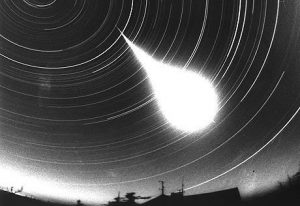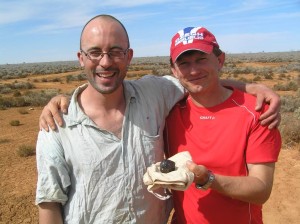
A meteor captured with a wide angle camera that is part of the European Fireball Network (Credits: Institute of Astronomy, Czech Academy of Sciences).
There is nothing particularly rare about meteorites. More than 50,000 various pieces of space rock have been collected around the globe throughout the history. What is rare though is a meteorite that has been observed, whose descent through the atmosphere has been recorded, and whose trajectory has been subsequently calculated (including the path in the Solar System prior to the collision with the Earth), together with the changes of its physical properties during the fall. If such a meteorite is retrieved, it becomes a meteorite with something that we might call a “Birth Certificate.” Out of those 50,000 space rocks, there are only nineteen with these “Birth Certificates” and the current Russian meteorite is bound to become the 20th and without doubt, also the largest by far.
To get more insight into meteorite hunting, Space Safety Magazine got in touch with astronomer Pavel Spurny, the head of the European Fireball Network and specialist in reconstructing meteorite paths from recorded images. “I am pretty sure that since the 1970s when we have global observation systems in place, there hasn’t been any space rock as massive as this one to hit the Earth,” he says.

Astronomer Pavel Spurny (on the right) and his colleague Phil Blund after recovering the Australian meteorite Bunburra Rockhole (Credits: Astro.cz)
Everyone around the globe must have been truly relieved that the Russian meteorite, exploding with the energy of 30 Hiroshima nuclear bombs, didn’t come crashing down on some densely populated city; one might wonder whether Spurny and his colleagues aren’t a bit disappointed though. The space rock of the century escaped the complex network of wide angle cameras that they have built throughout Europe, and helped to deploy in Australia and Canada. “Unfortunately, the Russian meteorite landed about 3 or 4000 kilometers away from our stations in Europe, and as the effects accompanying the descent took place in the altitude between 100 and 10 kilometers above Earth’s surface, our cameras in central Europe couldn’t have captured it,” he explains.
The scientific community is lucky that not only the CCTV cameras in the town of Chelyabinsk, but many witnesses also captured the event with their smartphones and car-mounted cameras. “People recorded this event not only in Chelyabinsk but in the area of 500 kilometers around the town. That’s quite unique,“ says Spurny. “To be able to extract all the information from the imagery, the data need to be precisely calibrated. We have a good deal of experience in that field and are in touch with our Russian colleagues. We’ll see if any further cooperation will stem out of it.”
Spurny, who led the teams recovering, for example, the 2002 German meteorite Neuschwanstein and Australian meteorites Bunburra Rockhole and Mason Gully, says that the recent Russian meteorite was probably ten times bigger when entering the atmosphere than the so far largest meteorite recovered from Tagish Lake in Canada in 2000. “By now, the mass of meteorite fragments that reached the ground after a single collision was usually counted in kilograms, I believe that in the case of this Russian meteorite, there will be tons of material found on the Earth’s surface.”
It seems the whole event serves as a powerful wake-up call, for the general public and the expert community alike, regarding the seemingly low probability of an asteroid impact. Spurny confirms that there was no way to spot the Russian meteorite with existing technology as it approached Earth from the direction, and against a backdrop, of the Sun. That sounds kind of scary – NASA estimated the Russian meteorite was about 17 meters in diameter when entering the Earth’s atmosphere; asteroid DA14 2012 which performed a historically near flyby on the very same day was only slightly more than twice that size in diameter (approximately 40 meters). What would have happened if it was the larger of the two coming from the Sun on the trajectory of the Russian meteorite? “In this case, the Earth’s atmosphere still had enough protective power to slow the rock down to the free fall speed. But we don’t know whether it would have worked with a body twice that size in diameter. It could happen that the asteroid would partially retain its original velocity and then the consequences would have been much worse.” The average speed of an asteroid travelling in space is 25 kilometers per second, if the Asteroid DA14 2012 had hit the Earth, the impact velocity would have been 12.7 kilometers per second.
Soon after the giant space rock came crashing down in Russia, observers reported sightings of smaller phenomena in Cuba and California, Spurny says that there is nothing unusual about it. Meteors – the light phenomena related to space rocks burning in the atmosphere – are common on a global scale. Most of them burn completely and don’t result in a fall of a meteorite to Earth’s surface. And even if they do, as long as no one is injured, it is usually only the meteorite hunting community who gets excited. According to data available, approximately 10 kilograms of meteorites fall annually on an area of 1,000,000 square kilometers.
Apart from the obvious attention that the concept of asteroid protection will finally get after the Russian incident, Spurny believes that the whole event will help scientists improve the understanding of how such massive bodies behave in the atmosphere: “So far, we haven’t had any direct experience with such a large object. I can say that the Russian meteorite has confirmed our expectations but it’s always good to have real data.”
The following video shows some examples of fireballs recorded by the European Fireball Network
[youtube http://www.youtube.com/watch?v=9hdyBO_0Rtc]























![A trajectory analysis that used a computational fluid dynamics approach to determine the likely position and velocity histories of the foam (Credits: NASA Ref [1] p61).](http://www.spacesafetymagazine.com/wp-content/uploads/2014/05/fluid-dynamics-trajectory-analysis-50x50.jpg)



Leave a Reply